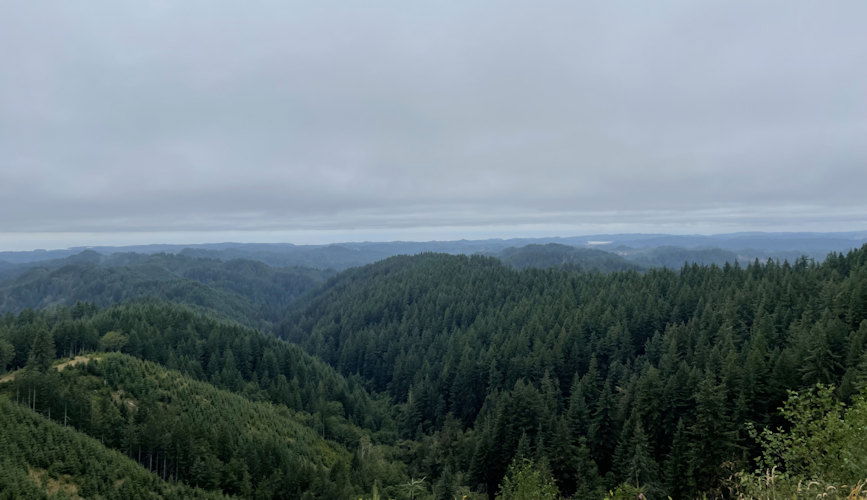Oregon inks agreement with developers to enter entire Elliott State Forest into carbon market

By Alex Baumhardt, Oregon Capital Chronicle
SALEM, Ore. (KTVZ) -- Oregon is one step closer to using a state forest to help capture and store more planet-warming greenhouse gases, and to fight climate change and earn money through the carbon market.
Leaders at the Department of State Lands signed a development agreement Thursday to enter all of the nearly 83,000-acre Elliott State Forest near Coos Bay into the voluntary carbon market for 40 years. The project will be managed by the carbon brokerage and development company Anew Climate, with offices in Houston, Texas, Salt Lake City, Utah and Calgary, Canada.
It’s the first such agreement on state-owned lands in the western United States, according to the state lands department. Michigan is the only other state that has entire state-managed forests generating credits for the carbon markets, with two of its state forests listed in the American Carbon Registry, the first voluntary greenhouse gas registry in the world that monitors projects and issues carbon credits. Those projects were developed by Anew Climate.
How do forests store carbon dioxide? And how do carbon crediting markets work?
In exchange for limiting logging and improving forest management, the Elliott State Forest carbon project is expected to capture and store hundreds of thousands of metric tons of additional planet-warming carbon dioxide from the atmosphere. This would generate hundreds of thousands of carbon credits — worth millions of dollars — for the land department over the next decade, according to a November 2023 draft analysis between Anew Climate and the state.
The final agreement shared with the Capital Chronicle on Thursday was heavily redacted and did not include any of the finalized financial aspects of the project.
“We won’t know how many credits will be generated or how much revenue the state will receive until we actually develop the carbon project,” said Ali Hansen, a lands department spokesperson, in an email. “It’s not that we’re not disclosing, it’s that this agreement gets the ball rolling on work to make the project happen.”
The agreement with Anew Climate follows an Oct. 15 vote by the State Land Board on a management plan for the 83,000-acre forest near Coos Bay that prioritizes research, protecting animal habitat, increasing forest carbon storage to combat climate change and producing income from the sale of carbon credits.
Gov. Tina Kotek, one of the three members of the State Land Board who voted for the new Elliott Forest management plan, along with Secretary of State LaVonne Griffin-Valade and state Treasurer Tobias Read, said in a news release it will help Oregon meet targets for curbing planet-warming greenhouse gas emissions.
“We need bolder action to fight climate change,” Kotek said. “Enrolling the Elliott State Research Forest in the carbon market will help meet our state’s climate goals and respond to a future of increasing uncertainty.”
Next steps
Officials at the Department of State Lands anticipate that the forest management plan, including the carbon plan, will go into effect next year, following finalization of a habitat conservation plan currently being reviewed by federal agencies.
The next step for the state and the developers at Anew Climate is to begin inventorying the carbon in the forest, measuring the additional carbon that they expect will be stored as compared with past use and “business as usual” logging practices in surrounding forests and getting the project independently verified by third-party auditors. Once this is complete, carbon credits can begin to be awarded and eventually sold on the voluntary carbon market.
Under the agreement, the forest will be enrolled in the American Carbon Registry. Credits generated will be sold to companies that want to buy carbon credits not because they must under government regulations, but because they want to show that they are trying to reduce the impact of their pollution.
The November draft analysis from Anew Climate showed the Elliott State Forest can be managed to capture and store up to 435,000 additional metric tons of carbon dioxide in the next 40 years — the equivalent to taking about 100,000 gas-powered cars off roads for a year. Each ton would be worth one carbon credit that could be sold to companies to offset some of their greenhouse gas emissions. The credits could be worth nearly $9 million on the voluntary carbon market over the next decade, Anew Climate’s analysis said.
The voluntary carbon crediting market has come under scrutiny in recent years for lacking regulations and oversight to ensure each ton of carbon dioxide released by a polluter is offset by a metric ton absorbed by a landowner.
Critics also say they provide only a temporary solution for harmful emissions that cause climate change. After a 40- or 100-year contract for carbon storage has been fulfilled, a landowner could log it all, or use the land for something else. Others worry the markets only delay a necessary transition away from fossil fuels within the next century by letting polluters buy their way out of making urgent changes.
Under the plan, logging will still be allowed in parts of the forest but will be significantly reduced from previous decades.
The Elliott was intensively logged for much of the last century to provide revenue for Oregon schools. Between 1993 and 2016, the state averaged 20 million board feet in harvests from the forest per year, but some years were heavier than others, and in the early 2000s, 30 million to 40 million board feet were coming off the Elliott to fund schools. Logging for school revenue largely stopped in 2016, and in 2022, it became a research forest. Today, it is among the largest research forests in the nation.
Reporting for this story was supported by the MIT Environmental Solutions Journalism Fellowship.